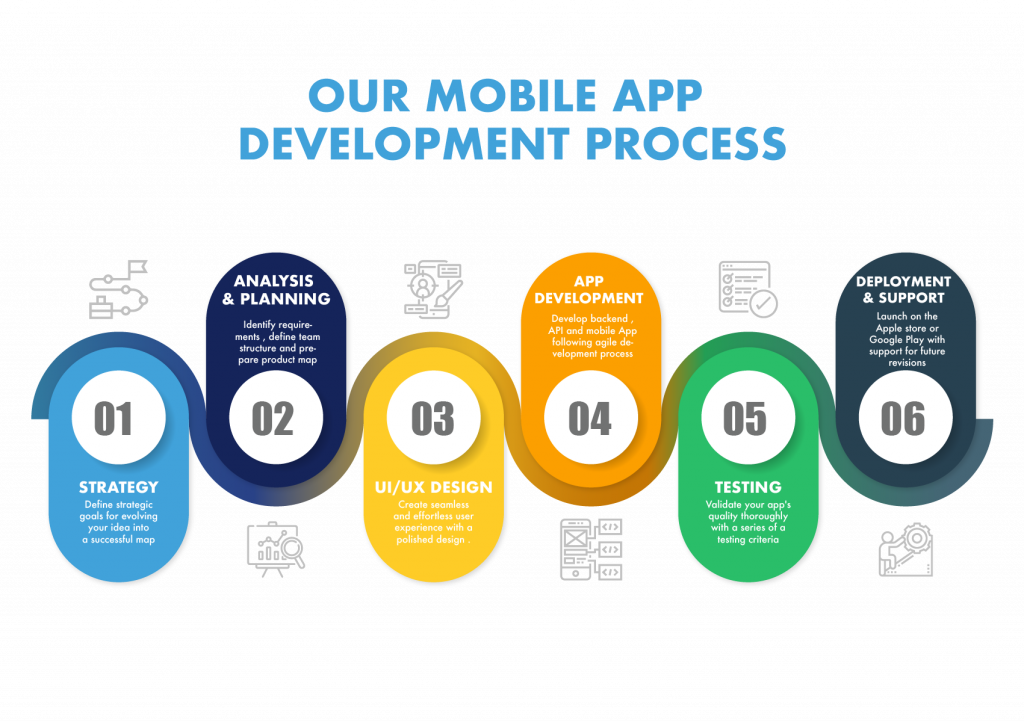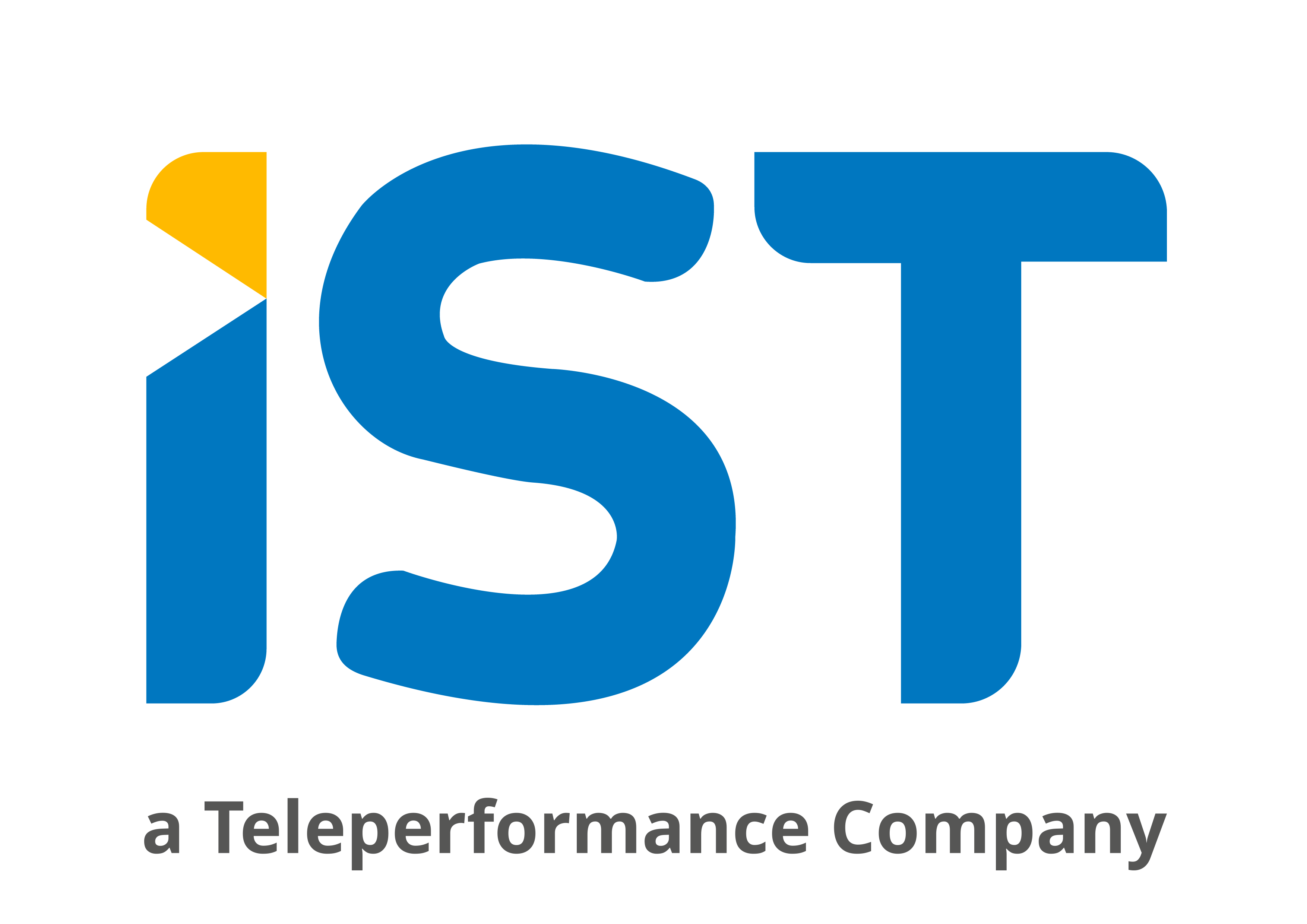
1. Strategy
First, the mobile app development process defines the strategy for growing your idea into a successful app. You may include a more major part of this in your overall enterprise mobility strategy. While one app’s objectives may differ from another, there is still an app-specific influence to the mobility strategy to address during the development process.
In this phase, you will:
- Identify the app users
- Study the competition
- Found the app’s goals and objectives
- Select a mobile platform for your app
Your plan helps focus your vision on a clear image of your app idea. With this in mind, you can go deeper into the next stage of the mobile application development process.
2. Analysis and Planning
At this stage, your app idea twitches taking shape and turns into an actual project. Analysis and planning begin with defining use cases and capturing comprehensive functional requirements.
Once you have acknowledged the requirements for your app, prepare a product roadmap. This includes arranging the mobile app requirements and grouping them into delivery indicators. If time, resources or costs are a concern, then define your minimum-viable-product (MVP) and prioritize this for the initial launch.
Part of the planning phase includes identifying the skills needed for your project. For example, iOS and Android mobile platforms use different development technology stacks. If your goals are to build a mobile app for both iOS and Android mobile stages then, your mobile development team should include iOS developers and Android developers.
Did you name you app yet? Mobile app names have to be unique within each app store. Research each app store specifically to ensure your app’s name isn’t already in use!
3. UI / UX Design
The purpose of an app’s design is to deliver seamless and effortless user experiences with a refined look.
The success of a mobile app certainly hinges on how well users are adopting and benefiting from all its features. The goal for mobile app UI / UX design is creating excellent user experiences making your app collaborating, natural, and accessible. While refined UI designs will help with early adoption, your app must have intuitive user experiences to keep app users’ engaged.
Information Architecture & Workflows
The first step of your mobile app design process is to determine the data your mobile app will display to the users, the data it will collect, user connections with the finished product, and the user journeys within the app.
Enterprise mobility solutions have users with different roles and rights, so it is critical to include these rules as part of your app’s information planning. Workflow diagrams help identify every possible interaction a user has with the app and the app’s navigation structure.
Style Guide
Style guides are “living documents” housing an app’s design standards from branding to the navigation icons.
Guidelines for standards include:
- What font family will your app’s text use?
- What will the color scheme be?
- How will your brand be reflected in the app’s design?
Style guides give to an app’s design strategy. Establishing a style guide early on improves the productivity of your team behind the mobile app development process. At the same time, keeping your app’s look and feel consistent.
4. App Development
Planning remains an essential part of this phase in the mobile app development process. Before actual development/programming efforts start, you will have to:
- define the technical planning,
- pick a technology stack, and
- Define the development indicators.
A typical mobile app project is made up of three integral parts: back-end/server technology, API(s) and the mobile app front-end.
Back-End/Server Technology
This part includes database and server-side objects essential for supportive functions of your mobile app. If you are using an existing back-end platform, then modifications are needed for supporting the chosen mobile functionality.
API
An Application Programming Interface (API) is a method of communication between the app and a back-end server/database.
Mobile App Front-End
The front-end is the native mobile app an end-user will use. In most cases, mobile apps contain of communicating user experiences that use an API and a back-end for managing data. In some cases, when an app needs to allow users to work without internet access, the app may utilize local data storage.
You can apply almost any web programming language and databases for the back-end. For native mobile apps, you have to choose a technology stack required by the targeted mobile platform. iOS apps can be developed using Objective-C or Swift programming language. Android apps are primarily built using Java or Kotlin.
There is more than one programming language and technology stack for building mobile apps —the key is picking a technology stack that is best suited for your mobile app.
Mobile technologies advance much faster with new versions of mobile platforms. Furthermore, new mobile devices are released every few months. With platforms and devices rapidly changing, agility is essential for building mobile apps within timelines and budgets. If time-to-market is a priority, use an agile development approach. This approach supports frequent software releases with completed functionality. Defining development milestones as part of the agile development plan supports developing your mobile application in an iteration.
As each development milestone completes, it passes on to the app testing team for validation.
5. Testing
Performing thorough quality assurance (QA) testing during the mobile app development process makes applications stable, usable, and secure. To ensure comprehensive QA testing of your app, you first need to prepare test cases that address all aspects of app testing.
Alike to how use cases drive the process of mobile app expansion, test cases drive app testing. Test cases are for recording testing results for software quality evaluation and tracking fixes for retesting. A best practice approach is involving your QA team in the Analysis and Design stages. Their understanding with your app’s functional requirements and objectives will help produce accurate test cases.
Your app should undergo the following testing methods, to deliver a quality mobility solution
User Experience Testing
A critical step in mobile app testing is to ensure that the final implementation matches the user experience created by the app design team. Visuals, workflow, and interactivity of your app are what will give your end users first-hand impression of your app. Make sure that your app employs consistent fonts, style treatments, color scheme, padding between data, icon design, and navigation. Ensuring that your app matches the original design guidelines will have a direct impact on its user acceptance!
Functional Testing
The accuracy of your mobile app functionality is critical to its success. It’s difficult to predict every end user’s behavior and usage scenario.
The functionality of your app should be tested by as many users to cover as many potential testing conditions as possible. It might surprise you to catch bugs when two different users test the same feature but get varied outcomes. For example, both users can fill out the same form, but they both might enter different data—which could lead to discovering a defect.
The purpose of functional testing is to ensure that users can use your app’s features and functionality without any issues. It can be broken down further into system testing (the app working as a whole), and unit testing (individual functions of the app operating correctly).
If you are building an app for iOS and Android mobile platforms, then your functional testing should include a feature comparison between both versions of your mobile app.
Performance Testing
There are many quantitative criteria to use for measuring the performance of your app.
- How well is your app responding to the user requests?
- How fast are the app’s screens loading?
- Is your app draining the phone battery or causing memory leaks?
- Does your app leverage network bandwidth efficiently?
- Is the size of your app bigger than what it should be?
Even when your app passes basic performance criteria, test the app, API, and backend for load by simulating the maximum number of concurrent users. Your app should be able to handle the load and perform well even when usage spikes.
Security Testing
Security is of utmost concern for enterprise mobile apps. Any potential vulnerability can lead to a hack. Many companies hire outside agencies to perform thorough security testing on their applications. Your QA and development teams can take a few simple measures to make your app secured.
Ensure that any APIs used by your app for interfacing with the backend use “HTTPS” protocol. This is a standard way of securing communication between your app and its backend. Note: you must have an SSL certificate installed on your backend for this to work correctly.
If your app requires users to log in, these log in sessions should be tracked on the device and the backend. User sessions should be terminated by the system when a user has remained idle for an extended time (typically ten mins or less on a mobile app). If your app stores user credentials on the device to make it convenient for them to re-login, then you must ensure using a trusted service. For example, iOS provides the Keychain feature that stores a user’s account details for a specific app.
Data entry forms within your mobile app should be tested to ensure there is no data leakage.
Device and Platform Testing
On average, new mobile devices enter the market every 12 months with new hardware, firmware, and design. Mobile operating systems are updated every few months.
Multiple mobile device manufacturers like Samsung, LG, HTC, Motorola use the Android platform, but they customize the platform for their mobile devices (since Android is open source). The devices come in different sizes and shapes.
Compare that to Apple, which has a lot more controlled environment, since they control both hardware and the OS. However, there are multiple iPhone & iPad (Apple iOS) devices out on the market.
Testing is imperative to an app’s future success; it encompasses a substantial section of our overall mobile app development process. Having a comprehensive mobile testing strategy is a must for delivering a quality mobile app.
During the testing phase, there are many ways for distributing your app development builds to the testers. The most common approach with iOS apps is using the Testflight and for Android apps via email or Over The Air (OTA) install.
6. Deployment & Support
Releasing a native mobile app requires submitting your app to the app stores including the Apple App Store for iOS apps and the Google Play for Android apps. For this reason, you will need a developer account with Apple App Store and Google Play Store before launching your mobile app.
An app’s release in the app store requires preparing metadata including:
- Your app’s title
- Description
- Category
- Keywords
- Launch icon
- App store screenshots
Once submitted in the Apple App Store, iOS apps go through a review process which may take from a few days to several weeks depending on the quality of your app and how closely it follows Apple’s iOS development guidelines. If your app requires users to log in, then you will need to provide Apple with a test user account as part of the release process.
There isn’t any review process with Android apps, and they become available in the app store within a few hours of submission.
Once your app becomes available in the app stores, monitor its usage through mobile analytics platforms and track Key Performance Indicators (KPIs) for measuring your app’s success. Frequently check crash reports, or other user reported issues.
Encourage users to provide you with feedback and suggestions for your app. Prompt support for end-users and frequently patching the app with improvements will be vital to keeping users engaged. Unlike web apps where patch releases can be available to app users instantly, mobile app updates will have to go through the same submission and review process as the initial submission. Moreover, with native mobile apps, you have to continually stay on top of technology advancements and routinely update your app for new mobile devices and OS platform.
For any mobile App development services contact us at www.istnetworks.com

